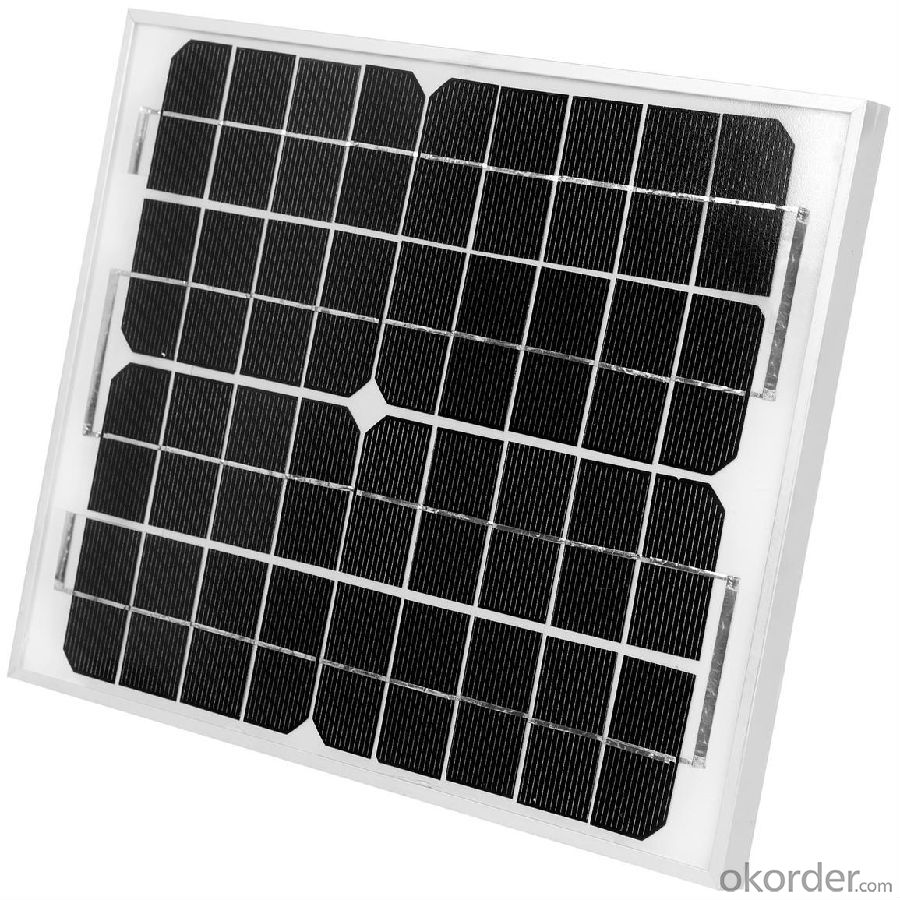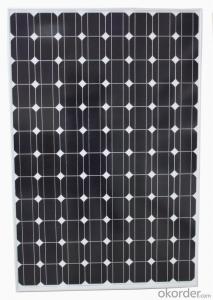Monocrystalline Silicon Solar Module 30W
- Loading Port:
- Shanghai
- Payment Terms:
- TT OR LC
- Min Order Qty:
- 10000 watt
- Supply Capability:
- 1000000 watt/month
OKorder Service Pledge
OKorder Financial Service
You Might Also Like
Item specifice
Product Description
Monocrystalline Silicon Solar Module 30W Product Description
Product Description
Monocrystalline or Polycrystalline solar cells, range from 5Wp to 290Wp.
Unique frame design to reinforce sealing and there are drainage holes on the border components, eliminate the framework of deformation caused by rain or snow accumulated in the framework.
Strong aluminum frames to strengthen the load hold and to stand against high wind.
Special mounting holes on the frames suitable for long term mounting.
High transparency low iron tempered glass with enhanced stiffness and impact resistance property.
Advanced EVA encapsulation system with multi-layer back sheets to better product modules
Specifications for Mono-crystalline Silicon Solar Module with 30W Maximum Power
Mechanical Characteristics | |
| Cell type | mono-crystalline silicon solar cells |
| Cell layout | 4*9 |
| Number of cells | 36pcs |
| Module dimensions | 477*536*25mm |
| Frame | anodized aluminum,grey or black |
| Junction box | IP65 |
| Connectors | MC4 or MC4 compatible(optional) |
| Net weight | 3.0kg |
| Packing | 7pcs/ctn |
| Electrical Characteristics | |
| Peak power(Pmax) | 30W |
| Power tolerance | ±3% |
| Max.system voltage | 715VDC |
| Open circuit voltage(Voc) | 21.5V |
| Short circuit current(Isc) | 1.91A |
| Max.power voltage(Vmp) | 17.5V |
| Max.power current(Imp) | 1.71A |
| Temperature coefficients of Isc | 0.035%/ºC |
| Temperature coefficients of Voc | -0.33%/ºC |
| Temperature coefficients of Pmax | -0.43%/ºC |
| Cell Efficiency | ≥17% |
| FF | 73% |
| Standard Test Condition(STD) | Irradiance:1000W/m²;Cell temperature:25ºC;AM:1.5 |
Features:
1) High reliability with guaranteed +/-3% output power tolerance
2) The modules can withstand high wind-pressure, snow loads and extreme temperatures
3) Bypass diodes to minimize power loss with shading
4) High and stable conversion efficiency to ensure the highest quality
Quality and Safety
1) Industry leading power output warranty, 25 year 80%, 10 year 90% power warranty and 3 year power warranty
2) ISO9001: 2008 (Quality Management system) certified factory
3) Product Quality warranty & products Liability Insurance to guarantee and user' benefits
EN 6100-6-3: 2007 EN 6100-3-1: 2007(IEC 61000-4-2: 2008
Our advantages:
High quality materials: High insulation TPT, Anti-aging EVA
Focus on each process during manufacture
Experienced engineers and workers
Fast delivery: 7-15 DAYS High efficiency and long time warranty
- Q:Can solar panels be used in areas with high pollution levels?
- Yes, solar panels can be used in areas with high pollution levels. While pollution levels may slightly reduce the efficiency of solar panels due to decreased sunlight reaching the panels, they can still generate electricity. Additionally, solar panels can help mitigate pollution by providing clean and renewable energy, reducing reliance on fossil fuels and contributing to a cleaner environment.
- Q:Hi, I am starting to get curious about the pros/cons of installing solar panels - has anyone done it and is it worth it?
- In the state of Pennsylvania in the USA, a very basic 5KW solar installation will cost you $35,000. Of that you will recover approximately $28,000 over the next five (5) years between the State and the Feds. Making your net-cost something between $7,000 and $9,000 depending on various factors. All other things being equal in a standard household with fuel-based heat and window units vs. central AC, this system will provide roughly 50% of power required with a payback of approximately eight (8) years (with electricity at $0.4/kwh). The system has an estimated forty (40) year service life. Without _all_ the subsidies, the payback is longer than the estimated system life, especially if you consider the time-value of money. The life-cycle cost of a photo-voltaic array is horrendous. By that, I mean the total cost of producing the panels, installing them, and then removing them and disposing of them in an environmentally correct manner. All that added in and there is a negative payback. So, it all depends on what one defines as worth it. Putting the cost onto taxpayers via governmental subsidy to make an otherwise wretchedly expensive process viable may give you all sorts of warm-and-fuzzy feelings about renewable resources and reducing dependence on foreign oil and so forth. But the reality is that the true cost of solar panels exceeds that of nuclear power per KW delivered. Even today when nuclear plants start in the Billions-with-a-B in any currency you would care to name.
- Q:how to build a solar panel
- Build okorder
- Q:How can solar panels be integrated into building designs?
- Solar panels can be integrated into building designs in various ways, such as through rooftop installations, building-integrated photovoltaics (BIPV), solar facades, and solar windows. By incorporating solar panels into the design, buildings can generate renewable energy while minimizing the visual impact and maximizing energy efficiency.
- Q:Why can't they put solar-panels on the blades and sides of the 300-500 foot tall turbines? Wouldn't this increase effeciency? Therefore, boosting pay-back time, profits, energy-output?
- Good to know someone is thinking and coming up with original ideas, so thanks for contributing... Put a large powerful solar collector on the end of the turbine too i.e. facing the sky! Far as I know, solar works on day-light (doesn't have to face the sun). So your idea is not to be put down. Metal blade turbines - are heavy - wooden windmills - heavy... so some added weight to the wind-turbine's paddles would be OK robably. Great if solar device not made of glass (so unbreakable). I think panels on the roof are old hat...
- Q:How do solar panels affect the value of a home?
- Solar panels can have a positive impact on the value of a home. They are considered a valuable asset as they reduce energy costs and provide potential financial savings for homeowners. Solar panels also contribute to a greener and more sustainable lifestyle, which is increasingly valued by homebuyers. Additionally, homes with solar panels are often seen as more attractive and can stand out in a competitive real estate market, potentially increasing the overall value of the property.
- Q:what is the average cost, for a single family home, to install solar panels? I live in CA.
- Depends on the size of your home, how many appliances you want to run at one time, and how much sunlight you get because all of that determines how many panels you need and how many batteries you need to install. I checked into it earlier this year and it was going to take almost 25 years to pay for itself. They aren't cheap.
- Q:How much energy can solar panels generate?
- The amount of energy solar panels can generate depends on various factors such as the size and efficiency of the panels, the location and orientation of the installation, and the amount of sunlight available. On average, a typical solar panel can generate about 250 to 400 watts per hour. However, larger solar installations or those with higher efficiency panels can generate several kilowatts or even megawatts of energy, which is enough to power homes, businesses, or even entire cities.
- Q:Can solar panels be used to power a data center?
- Yes, solar panels can be used to power a data center. Solar panels convert sunlight into electricity, which can be used to power various devices and infrastructure, including data centers. By installing a sufficient number of solar panels and using energy storage systems, a data center can be powered entirely or partially by solar energy. This can help reduce reliance on traditional power sources, lower energy costs, and promote environmental sustainability. However, the feasibility and efficiency of using solar panels for powering a data center may depend on factors such as the location, size of the data center, and the availability of sunlight.
- Q:ASAP :) as much details as possible
- sounds like a homework essay question to me
1. Manufacturer Overview |
|
|---|---|
| Location | |
| Year Established | |
| Annual Output Value | |
| Main Markets | |
| Company Certifications | |
2. Manufacturer Certificates |
|
|---|---|
| a) Certification Name | |
| Range | |
| Reference | |
| Validity Period | |
3. Manufacturer Capability |
|
|---|---|
| a)Trade Capacity | |
| Nearest Port | |
| Export Percentage | |
| No.of Employees in Trade Department | |
| Language Spoken: | |
| b)Factory Information | |
| Factory Size: | |
| No. of Production Lines | |
| Contract Manufacturing | |
| Product Price Range | |
Send your message to us
Monocrystalline Silicon Solar Module 30W
- Loading Port:
- Shanghai
- Payment Terms:
- TT OR LC
- Min Order Qty:
- 10000 watt
- Supply Capability:
- 1000000 watt/month
OKorder Service Pledge
OKorder Financial Service
Similar products
New products
Hot products
Hot Searches
Related keywords




























